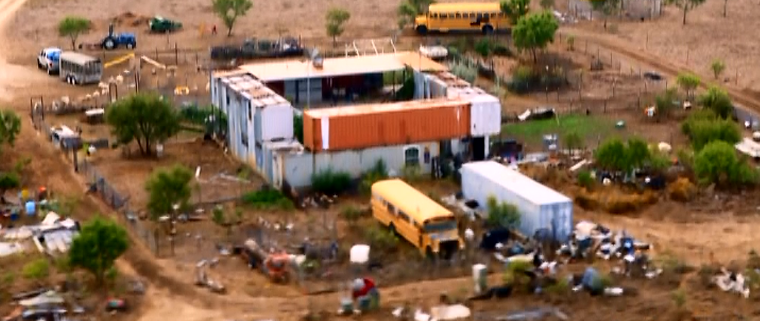New 'Doomsday Preppers' Show Highlights Extreme Survivalists

It's better to be safe than sorry, which is why FEMA guidelines recommend stockpiling your pantry with three days worth of food in case of a natural disaster. Meanwhile, Paul Range and Gloria Haswell have enough in store to feed 22 people for 15 years — as well as enough guns, bullets and bug-out vehicles to wage a small war. The couple occupies nine steel shipping containers arranged in a castle formation outside Floresville, Texas. A system of windmills and solar panels powers the compound, and human body waste is used to generate methane, which serves as their cooking fuel.
It's all because they are worried Earth's magnetic poles might switch.
Range and Haswell are among those profiled in "Doomsday Preppers," a weekly TV documentary premiering on the National Geographic Channel tomorrow (Feb. 7) at 9 p.m., with a bonus episode at 10 p.m. following the premiere. The show takes viewers on a shocking tour of modern-day apocalypse paranoia, from Range, Haswell and their steel fortress to a Californian who has trained himself to survive off garden weeds in preparation for a major earthquake.
While the show may highlight a few of America's most extreme cases, apocalypticism — fear of the end of the world as we know it — is at a historic high point, according to Lorenzo DiTommasso, chairman and associate professor of religion at Concordia University in Montreal. The phenomenon has experienced peaks and valleys throughout history. Right now, "we're in a peak, and have been for the last 40 years," DiTommasso said.
Fear of nuclear obliteration started the rise in apocalypticism, but today, the main factor driving its continuing spread is the rapid exchange of ideas — especially scary ideas — on the Web.
"There's no single more important explanation as to the presence of apocalyptic thought in the world today than the development of the Internet," DiTommasso told Life's Little Mysteries, a sister site to LiveScience. "You can learn everything you want about the flipping of the magnetic poles on the Internet. And you can find out related information that would lead you to also believe the poles are going to flip because of, for instance, the presence of a previously unknown planet in the solar system." [Believers In Mysterious Planet Nibiru Await Earth's End]
Indeed, doomsday preppers Range and Haswell have come to believe that the coming magnetic pole reversal will cause a sudden shift in the continents, triggering enormous earthquakes and rapid climate change. They've learned just enough to inspire a total lifestyle transformation — despite the scientific consensus that the chance of a magnetic pole reversal happening in their lifetimes is vanishingly small.
Sign up for the Live Science daily newsletter now
Get the world’s most fascinating discoveries delivered straight to your inbox.
Others profiled in the show fear a total financial collapse, an electro-magnetic pulse caused by a solar flare taking down the national power grid,terrorist attacks and so on. "People come to apocalypticism for different reasons, and once they're there they share a set of assumptions that defines the group: First, they believe there is something dreadfully wrong with the world, and it's not likely to be fixed. The second part is they believe an imminent change is coming about," DiTommasso said.
He estimates that more than half of the world population believes in some sort of apocalyptic theory, from the Christian, Jewish and Muslim belief in the return of God (called the Rapture in Christianity), to the belief in pseudo-scientific theories like a coming planetary collision. The current peak in doomsday fears, DiTommasso said, "speaks to the prevalence of doomsday preppers today."
Personally, DiTommasso believes apocalypticists are correct in recognizing that there are grave threats in the world, but they're misguided as to what forms these will take. "You don't have to expect an apocalypse," he said. "Look outside — the environment is being degraded right now. Instead of standing outside, looking up for the comet that's going to obliterate the Earth, look around you."
Follow Natalie Wolchover on Twitter @nattyover. Follow Life's Little Mysteries on Twitter @llmysteries, then join us on Facebook.
Natalie Wolchover was a staff writer for Live Science from 2010 to 2012 and is currently a senior physics writer and editor for Quanta Magazine. She holds a bachelor's degree in physics from Tufts University and has studied physics at the University of California, Berkeley. Along with the staff of Quanta, Wolchover won the 2022 Pulitzer Prize for explanatory writing for her work on the building of the James Webb Space Telescope. Her work has also appeared in the The Best American Science and Nature Writing and The Best Writing on Mathematics, Nature, The New Yorker and Popular Science. She was the 2016 winner of the Evert Clark/Seth Payne Award, an annual prize for young science journalists, as well as the winner of the 2017 Science Communication Award for the American Institute of Physics.











